The Improvement of the Irradiation Resistance of Amorphous MoS2 Films by Thermal Annealing
Abstract
:1. Introduction
2. Materials and Methods
2.1. Material Preparation
2.2. Heavy Ion Irradiation
2.3. Structural and Properties Characterization
3. Results
4. Conclusions
Author Contributions
Funding
Institutional Review Board Statement
Informed Consent Statement
Data Availability Statement
Conflicts of Interest
References
- Jacobson, T. Dynamic friction and wear of a solid film lubricant during radiation exposure in a nuclear reactor. Contract 1972, 112, 29. [Google Scholar]
- Tesini, A.; Palmer, J. The ITER remote maintenance system. Fusion Eng. Des. 2008, 83, 810–816. [Google Scholar] [CrossRef]
- Koch, F.; Nocentini, R.; Heinemann, B.; Lindig, S.; Junhanns, P.; Bolt, H. MoS2 coatings for the narrow support elements of the W-7X nonplanar coils. Fusion Eng. Des. 2007, 82, 1614–1620. [Google Scholar] [CrossRef] [Green Version]
- Lingertat, J.; Gradt, T.; Hathiramani, D.; Junghanns, P.; Laux, M.; Meine, K.; Schauer, F.; Schneider, T. Tribological performance of MoS2 coatings in liquid helium and at high loads. Fusion Eng. Des. 2009, 84, 1192–1196. [Google Scholar] [CrossRef]
- Shi, S.; Song, Y.; Cheng, Y.; Villedieu, E.; Bruno, V.; Feng, H.; Wu, H.; Wang, P.; Hao, Z.; Li, Y.; et al. Conceptual design main progress of EAST Articulated Maintenance Arm (EAMA) system. Fusion Eng. Des. 2016, 104, 40–45. [Google Scholar] [CrossRef]
- Duan, Z.; Zhao, X.; Xu, J.; Wang, P.; Liu, W. Influence of Ni13+ ions irradiation on the microstructure, mechanical and tribological properties of Mo-S-Ti composite films. Appl. Surf. Sci. 2019, 480, 438–447. [Google Scholar] [CrossRef]
- Xu, J.; Dai, J.; Ren, F.; Wang, Y.; Wang, P.; Xu, S.; Wu, S.; Lin, J.; Yang, Y.; Guo, D.; et al. Ultrahigh radiation resistance of nanocrystalline diamond films for solid lubrication in harsh radiative environments. Carbon 2021, 182, 525–536. [Google Scholar] [CrossRef]
- Amaro, R.; Martins, R.; Seabra, J.; Renevier, N.; Teer, D. Molybdenum disulphide/titanium low friction coating for gears application. Tribol. Int. 2005, 38, 423–434. [Google Scholar] [CrossRef]
- Zhang, X.; Xu, J.; Chai, L.; He, T.; Yu, F.; Wang, P. Carbon and nitrogen co-doping self-assembled MoS2 multilayer films. Appl. Surf. Sci. 2017, 406, 30–38. [Google Scholar] [CrossRef]
- Nastasi, M.; Su, Q.; Price, L.; Santana, J.; Chen, T.; Balerio, R.; Shao, L. Superior radiation tolerant materials: Amorphous silicon oxycarbide. J. Nucl. Mater. 2015, 461, 200–205. [Google Scholar] [CrossRef] [Green Version]
- Zare, A.; Su, Q.; Gigax, J.; Shojaee, S.; Harriman, T.; Nastasi, M.; Shao, L.; Materer, N.; Lucca, D. Effects of ion irradiation on chemical and mechanical properties of magnetron sputtered amorphous SiOC. Nucl. Instrum. Methods Phys. Res. B 2019, 446, 10–14. [Google Scholar] [CrossRef]
- Baumer, R.; Demkowicz, M. Radiation response of amorphous metal alloys: Subcascades, thermal spikes and super-quenched zones. Acta Biomater. 2015, 83, 419–430. [Google Scholar] [CrossRef]
- Su, Q.; Inoue, S.; Ishimaru, M.; Gigax, J.; Wang, T.; Ding, H.; Demkowicz, M.; Shao, L.; Nastasi, M. Helium irradiation and implantation effects on the structure of amorphous silicon oxycarbide. Sci. Rep. 2017, 7, 3900. [Google Scholar] [CrossRef]
- Santana, J.; Mora, E.; Price, L.; Balerio, R.; Shao, L.; Nastasi, M. Synthesis, thermal stability and the effects of ion irradiation in amorphous Si-O-C alloys. Nucl. Instrum. Methods Phys. Res. B 2015, 350, 6–13. [Google Scholar] [CrossRef] [Green Version]
- Huang, L.; Chen, Z.; Liu, W.; Huang, P.; Meng, X.; Xu, K.; Wang, F.; Lu, T. Enhanced irradiation resistance of amorphous alloys by introducing amorphous/amorphous interfaces. Intermetallics 2019, 107, 39–46. [Google Scholar] [CrossRef]
- Demkowicz, M.; Hoagland, R.; Hirth, J. Interface structure and radiation damage resistance in Cu-Nb multilayer nanocomposites. Phys. Rev. Lett. 2008, 100, 136102. [Google Scholar] [CrossRef]
- Nita, N.; Schaeublin, R.; Victoria, M. Impact of irradiation on the microstructure of nanocrystalline materials. J. Nucl. Mater. 2004, 329, 953–957. [Google Scholar] [CrossRef]
- Chimi, Y.; Iwase, A.; Ishikawa, N.; Kobiyama, A.; Inami, T.; Okuda, S. Accumulation and recovery of defects in ion-irradiated nanocrystalline gold. J. Nucl. Mater. 2001, 297, 355–357. [Google Scholar] [CrossRef]
- Shen, T.; Feng, S.; Tang, M.; Valdez, J.; Wang, Y.; Sickafus, K. Enhanced radiation tolerance in nanocrystalline MgGa2O4. Appl. Phys. Lett. 2007, 90, 749–763. [Google Scholar] [CrossRef]
- Pérez-Pérez, F.; Smith, R. Structural changes at grain boundaries in bcc iron induced by atomic collisions. Nucl. Instrum Methods Phys. Res. Sect. B 2000, 164, 487–494. [Google Scholar] [CrossRef] [Green Version]
- Xu, S.; Hu, M.; Sun, J.; Weng, L.; Liu, W.; Gao, X. A simple strategy to tailor the microstructure and wear-resistance of sputtered WS2 films. Mater. Lett. 2018, 216, 179–181. [Google Scholar] [CrossRef]
- Zhang, Y.; Zhuang, Y.; Liu, L.; Qiu, P.; Su, L.; Teng, X.; Fu, G.; Yu, W. The microstructure evolution during MoS2 films growth and its influence on the MoS2 optical-electrical properties in MoS2/p-Si heterojunction solar cells. Superlattice. Microst. 2020, 137, 106352. [Google Scholar] [CrossRef]
- Spalvins, T. Tribological properties of sputtered MoS2 films in relation to film morphology. Thin Solid Films 1980, 73, 291–297. [Google Scholar] [CrossRef]
- Huang, J.; Kuo, K.; Yu, G. Oxidation behavior and corrosion resistance of vacuum annealed ZrN-coated stainless steel. Surf. Coat. Technol. 2019, 358, 308–319. [Google Scholar] [CrossRef]
- Abbas, Q.; Rodrigues, M.; Baco, S.; Guan, S.; Morley, N. Influence of annealing temperature on the structural and magnetic properties of FeGaSiB thin films. Thin Solid Films 2020, 701, 137955. [Google Scholar] [CrossRef]
- Aissani, L.; Fellah, M.; Radjehi, L.; Nouveau, C.; Montagne, A.; Alhussein, A. Effect of annealing treatment on the microstructure, mechanical and tribological properties of chromium carbonitride coatings. Surf. Coat. Technol. 2019, 359, 403–413. [Google Scholar] [CrossRef]
- Rao, E.; Ramanaiah, N. Influence of heat treatment on mechanical and corrosion properties of aluminium metal matrix composites (AA 6061 reinforced with MoS2). Mater. Today 2017, 4, 11270–11278. [Google Scholar]
- Zhang, R.; Cui, Q.; Weng, L.; Sun, J.; Hu, M.; Fu, Y.; Wang, D.; Jiang, D.; Gao, X. Modification of structure and wear resistance of closed-field unbalanced- magnetron sputtered MoS2 film by vacuum- heat-treatment. Surf. Coat. Technol. 2020, 401, 126215. [Google Scholar] [CrossRef]
- Ziegler, J.F.; Ziegler, M.D.; Biersack, J.P. SRIM-the stopping and range of ions in matter. Nucl. Instrum. Methods Phys. Res. B 2010, 286, 1818–1823. [Google Scholar] [CrossRef] [Green Version]
- Ogorodnikova, O.V.; Tyburska, B.; Alimov, V.K.; Ertl, K. The influence of radiation damage on the plasma-induced deuterium retention in self-implanted tungsten. J. Nucl. Mater. 2011, 415, S661–S666. [Google Scholar] [CrossRef]
- Renevier, N.; Hamphire, J.; Fox, V.; Witts, J.; Allen, T.; Teer, D. Advantages of using self-lubricating, hard, wear-resistant MoS2-based coatings. Surf. Coat. Technol. 2001, 142–144, 67–77. [Google Scholar] [CrossRef]
- Prins, R.; Beer, V. Structure and function of the catalyst and the promoter in Co-Mo hydrodesulfurization catalysts. Catal. Rev. Sci. Eng. 1989, 31, 1–41. [Google Scholar] [CrossRef]
- Zhou, H.; Zheng, J.; Wen, Q.; Wan, Z.; Sang, R. The effect of Ti content on the structural and mechanical properties of MoS2/Ti composite coatings deposited by unbalanced magnetron sputtering system. Phys. Procedia 2011, 18, 234–239. [Google Scholar]
- Fleischauer, P.; Lince, J. A comparison of oxidation and oxygen substitution in MoS2 solid film lubricants. Tribol. Int. 1999, 32, 627–636. [Google Scholar] [CrossRef]
- McDevitt, N.; Donley, M.; Zabinsk, J. Utilization of Raman spectroscopy in tribochemistry studies. Wear 1993, 166, 65–72. [Google Scholar] [CrossRef]
- Lee, C.; Yan, H.; Brus, L.; Heinz, T.; Hone, J.; Ryu, S. Anomalous lattice vibrations of single and few-layer MoS2. ACS Nano 2010, 4, 2695–2700. [Google Scholar] [CrossRef] [Green Version]
- Cravanzola, S.; Muscuso, L.; Cesano, F.; Agostini, G.; Damin, A.; Scarano, D.; Zecchina, A. MoS2 nanoparticles decorating titanate-nanotube surfaces: Combined microscopy, spectroscopy, and catalytic studies. Langmuir 2015, 31, 5469–5478. [Google Scholar] [CrossRef]
- Zinkle, S.J.; Matsukawa, Y. Observation and analysis of defect cluster production and inter actions with dislocations. J. Nucl. Mater. 2004, 329, 88–96. [Google Scholar] [CrossRef]
- Duan, Z.; Zhao, X.; Qiao, L.; Zhao, Y.; Fu, E.; Wang, P. Structural evolution and wear resistance of MoS2-based lubricant films irradiated by heavy ions. Surf. Coat. Technol. 2019, 378, 125077. [Google Scholar] [CrossRef]
- Bullough, R.; Hayns, M.; Wood, M. Sink strengths for thin-film surfaces and grain-boundaries. J. Nucl. Mater. 1980, 90, 44–59. [Google Scholar] [CrossRef]
- Shen, T.; Gao, X.; Yu, K. Research progress of irradiation resistant nanomaterials. J. Yanshan Univ. 2014, 4, 283–298. [Google Scholar]
- Wang, H.; Araujo, R.; Swadener, J.; Wang, Y.; Zhang, X.; Fu, E.; Cagin, T. Ion irradiation effects in nanocrystalline TiN coatings. Nucl. Instrum Methods Phys. Res. Sect. B 2007, 261, 1162–1166. [Google Scholar] [CrossRef]
- Xiong, F.; Li, M.; Malomo, B.; Yang, L. Microstructural evolution in amorphous-nanocrystalline ZrCu alloy under neutron irradiation. Acta Mater. 2020, 182, 18–28. [Google Scholar] [CrossRef]
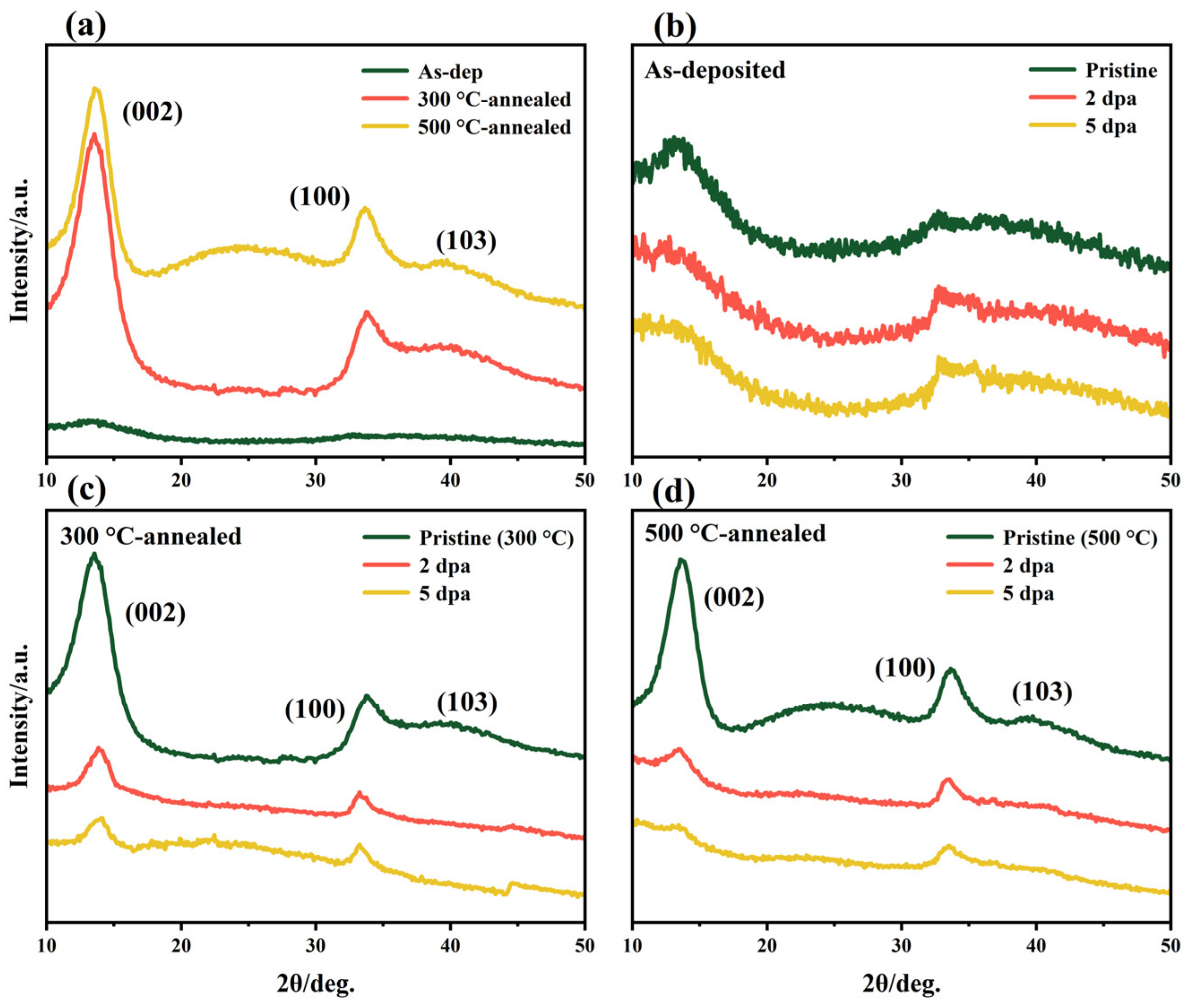
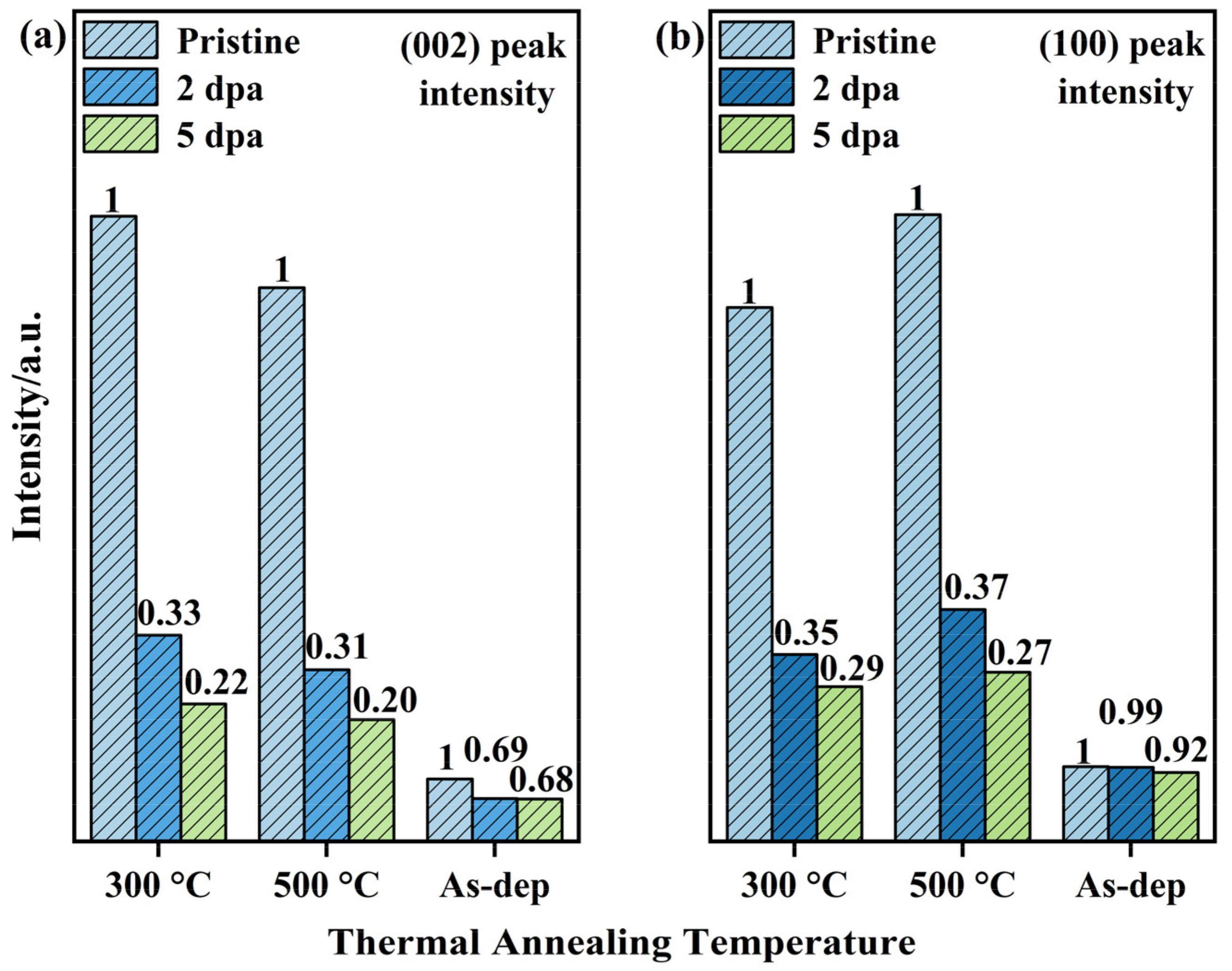
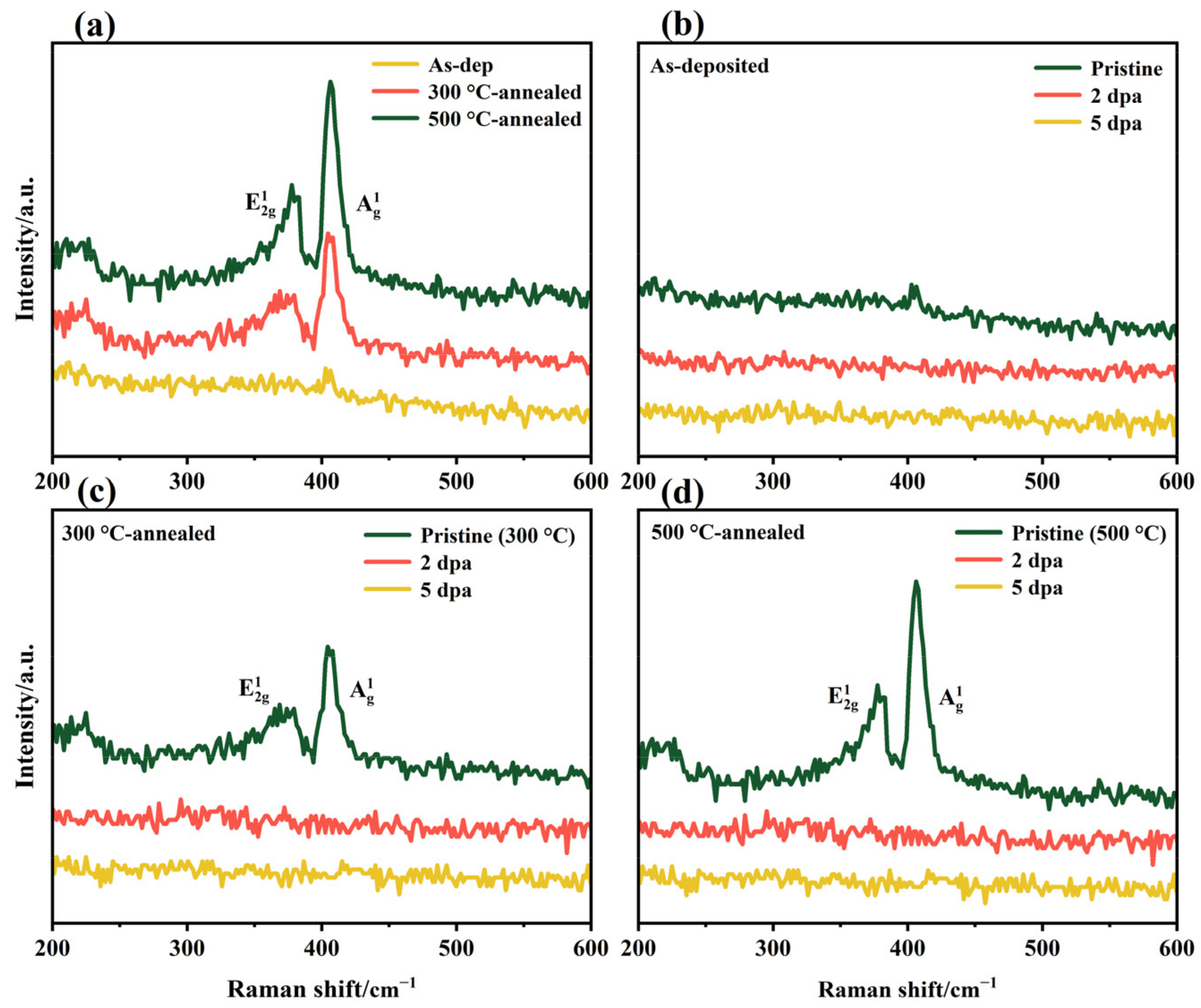


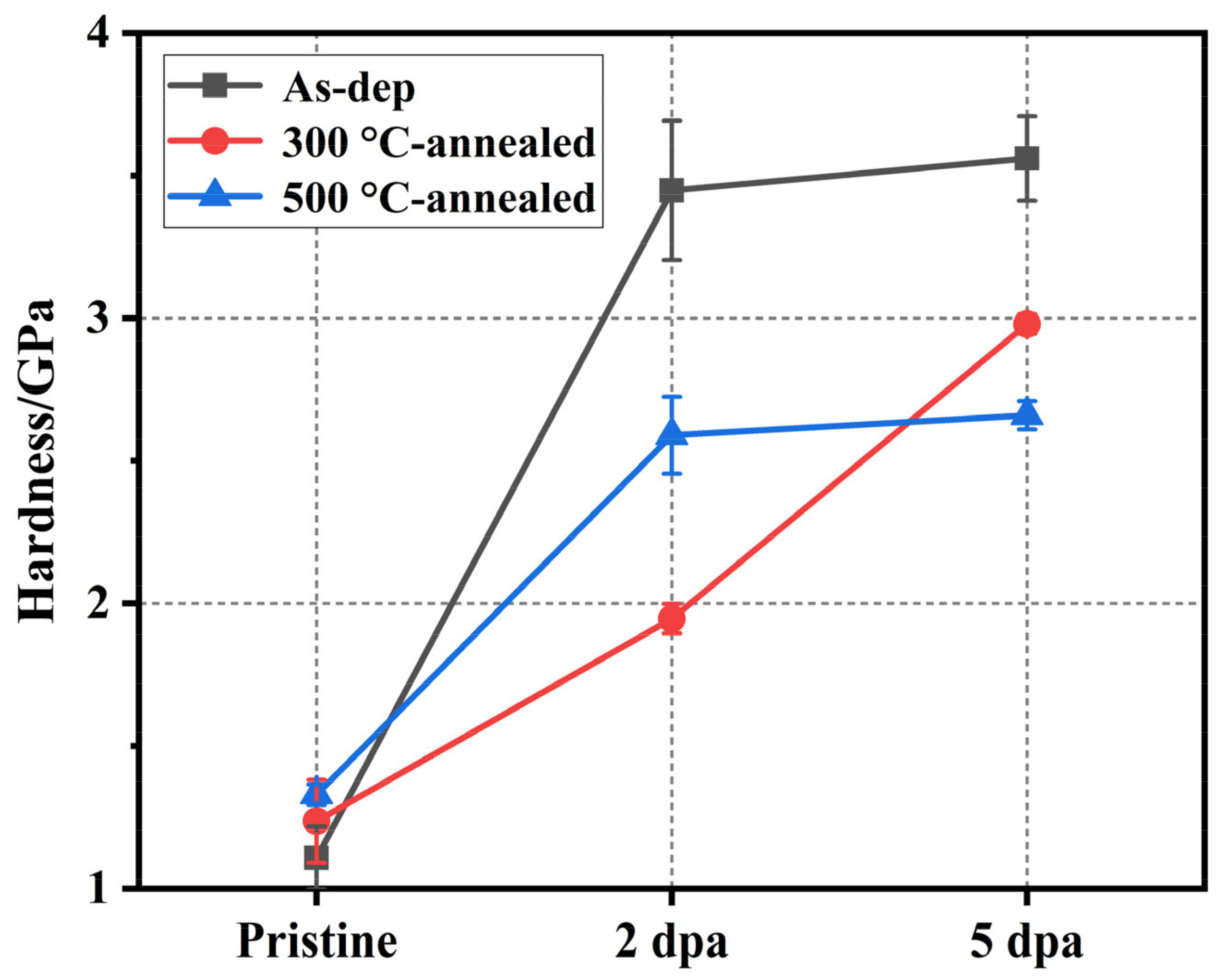
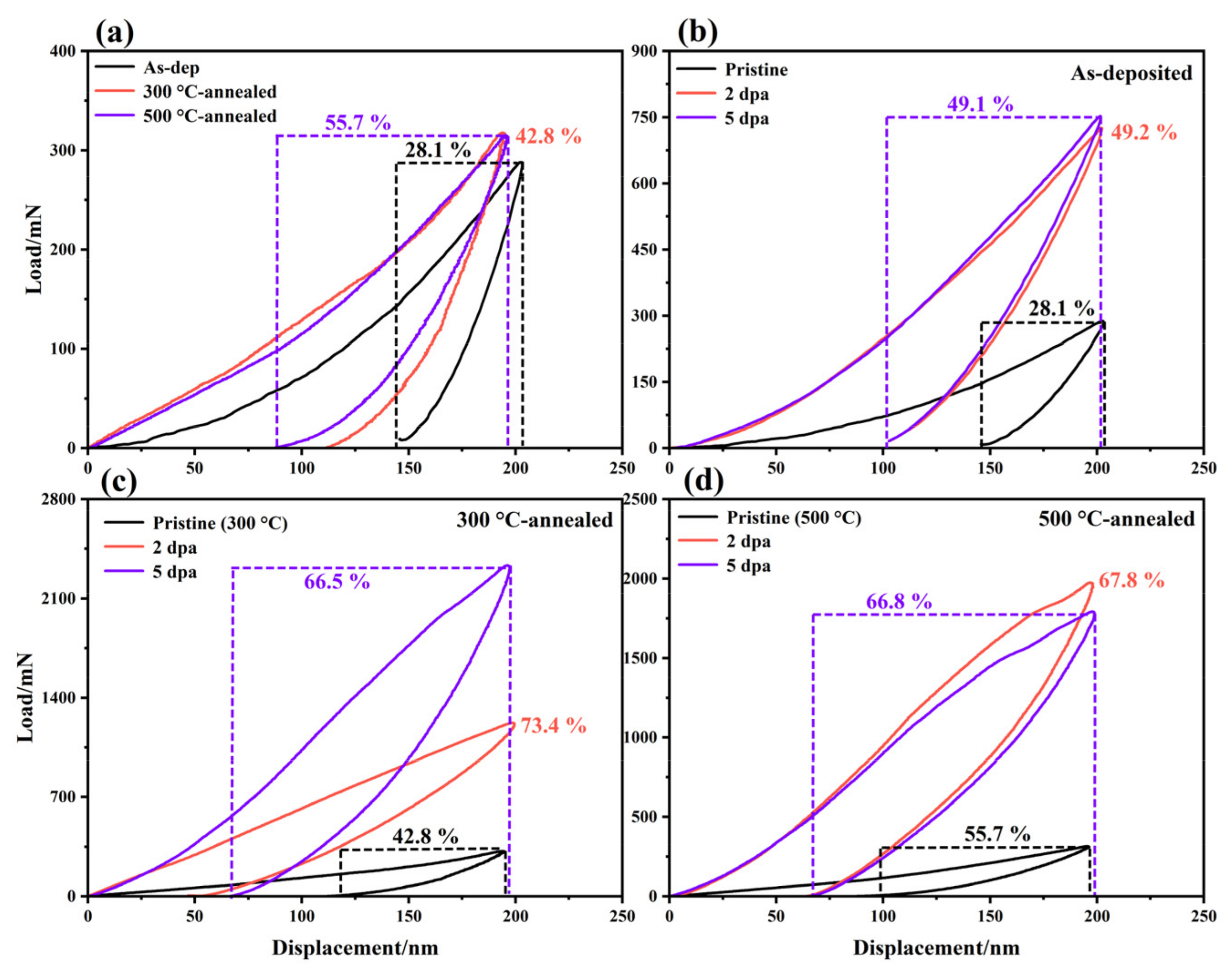
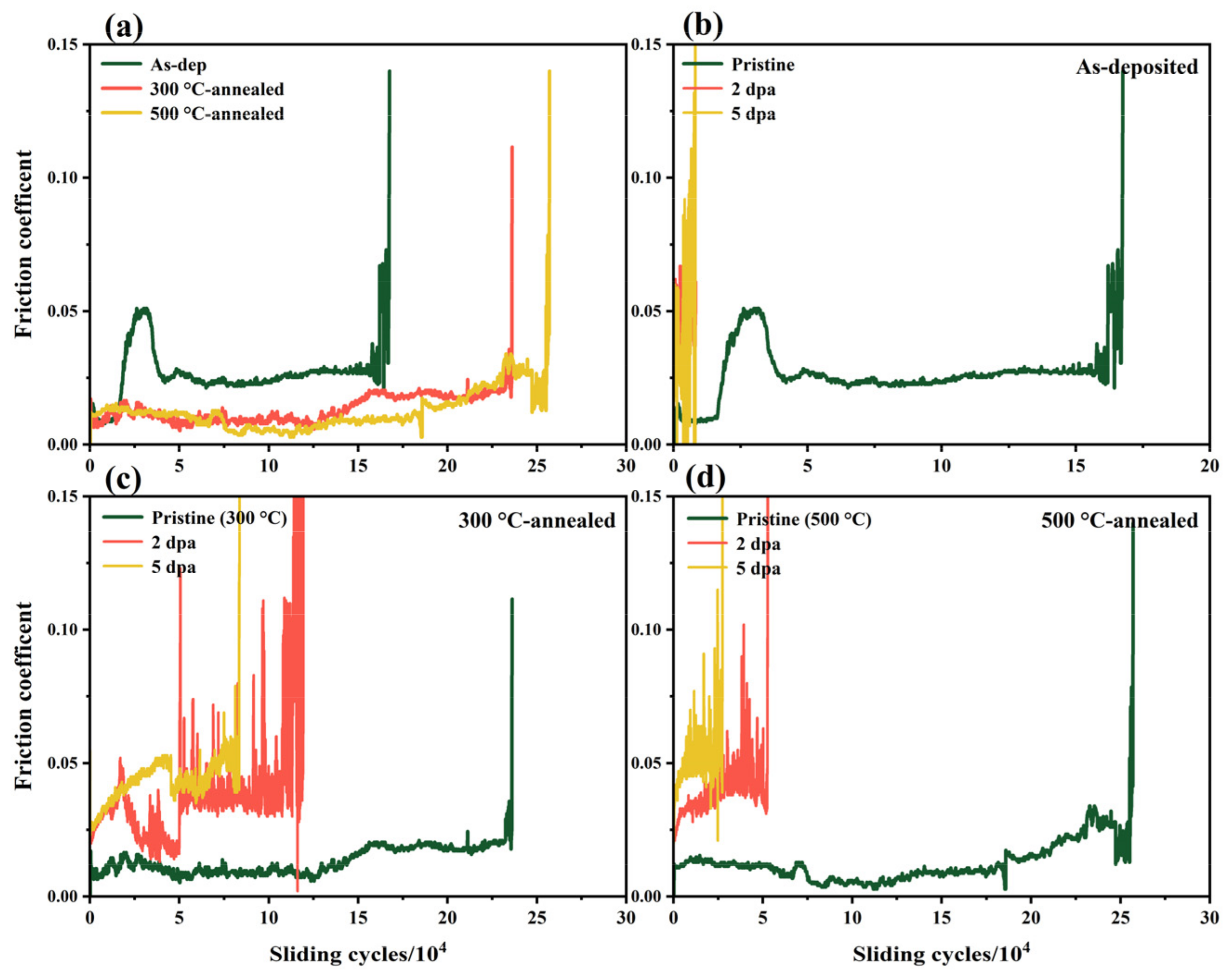
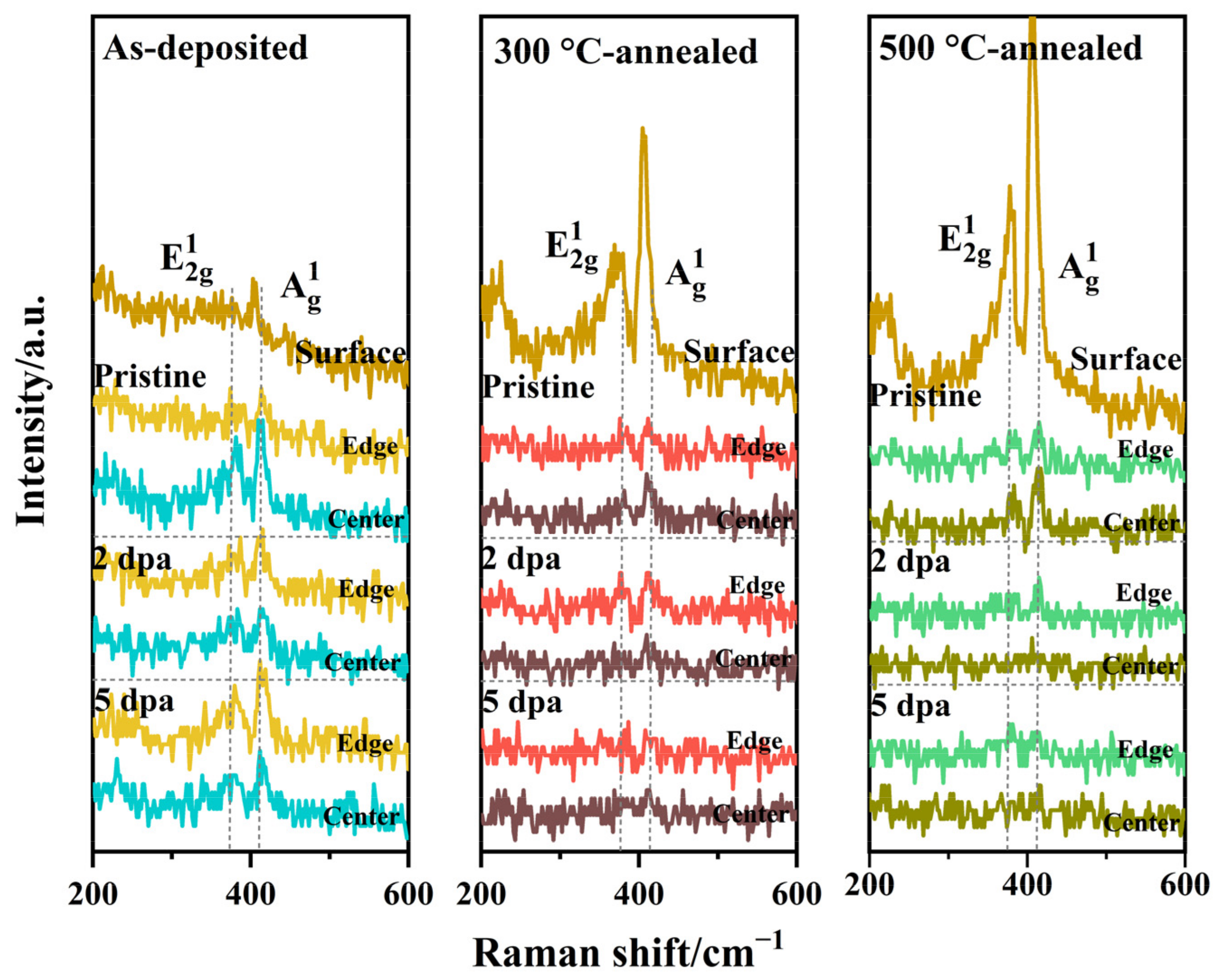
| Sample | Temperature (°C) | Chemical Composition (at. %) | |||
|---|---|---|---|---|---|
| Mo | S | O | S/Mo | ||
| MoS2 | -- | 30.50 | 50.36 | 19.14 | 1.65 |
| Annealed MoS2 | 300 | 31.01 | 52.99 | 16.00 | 1.71 |
| Annealed MoS2 | 500 | 30.34 | 55.13 | 14.53 | 1.82 |
Publisher’s Note: MDPI stays neutral with regard to jurisdictional claims in published maps and institutional affiliations. |
© 2022 by the authors. Licensee MDPI, Basel, Switzerland. This article is an open access article distributed under the terms and conditions of the Creative Commons Attribution (CC BY) license (https://creativecommons.org/licenses/by/4.0/).
Share and Cite
Zhang, R.; Zhang, H.; Gao, X.; Wang, P. The Improvement of the Irradiation Resistance of Amorphous MoS2 Films by Thermal Annealing. Nanomaterials 2022, 12, 364. https://doi.org/10.3390/nano12030364
Zhang R, Zhang H, Gao X, Wang P. The Improvement of the Irradiation Resistance of Amorphous MoS2 Films by Thermal Annealing. Nanomaterials. 2022; 12(3):364. https://doi.org/10.3390/nano12030364
Chicago/Turabian StyleZhang, Rui, Hong Zhang, Xiaoming Gao, and Peng Wang. 2022. "The Improvement of the Irradiation Resistance of Amorphous MoS2 Films by Thermal Annealing" Nanomaterials 12, no. 3: 364. https://doi.org/10.3390/nano12030364





